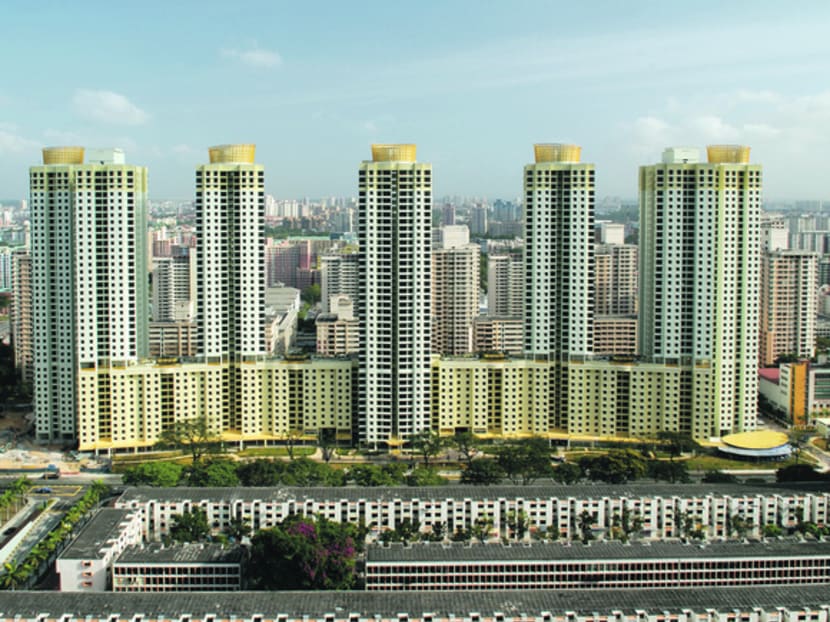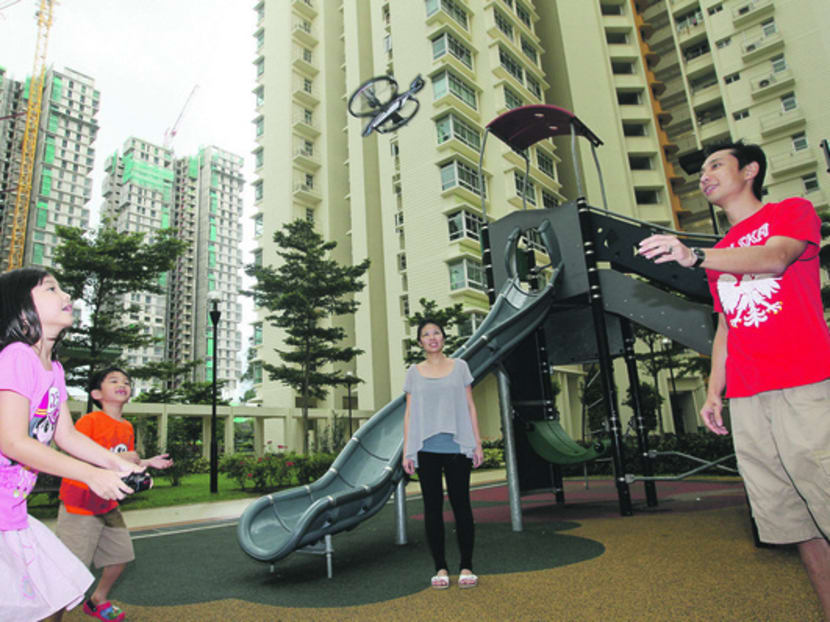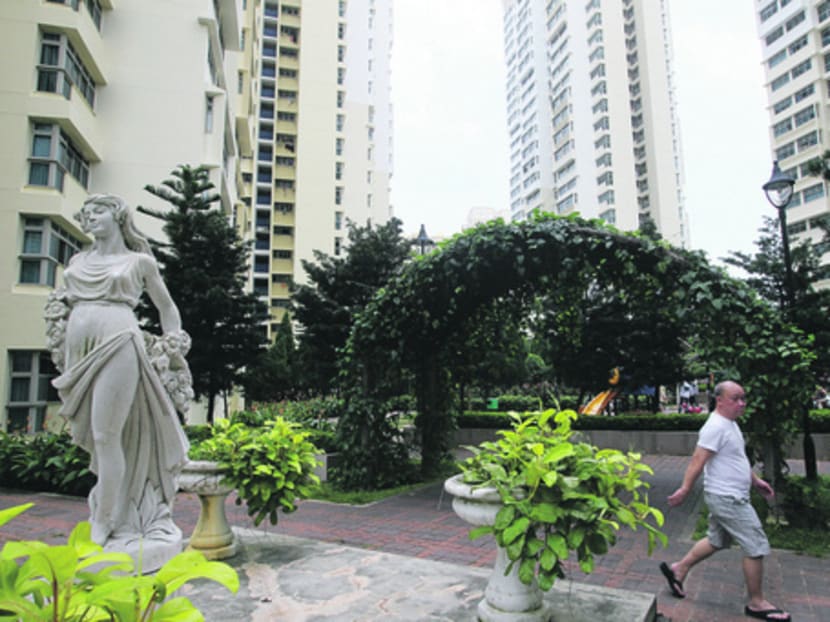New lease on life for older towns
There were movie dates with her late husband in the early 1980s at Queenstown cinema before they got married. Home after they tied the knot in 1984 was a three-room flat in Margaret Drive — until 2010, when the Strathmore Green precinct was completed, and Mdm Goh Keng Lan’s family moved to their new four-room flat, just a few hundred metres away.



There were movie dates with her late husband in the early 1980s at Queenstown cinema before they got married. Home after they tied the knot in 1984 was a three-room flat in Margaret Drive — until 2010, when the Strathmore Green precinct was completed, and Mdm Goh Keng Lan’s family moved to their new four-room flat, just a few hundred metres away.
What she likes about it? “The place is new,” said the 63-year-old housewife. Her old flat was beginning to age, with leaks in the kitchen and a spalling bathroom ceiling.
There are also new estate amenities, like the exercise area. “We didn’t have jogging paths previously, only the stadium nearby,” she said.
By contrast, Mr Chiu Weixiong, 30, and his wife Mabel Ong, 29, only moved into Queenstown recently — drawn by the locale, they bought their Strathmore Green flat through a Sale of Balance Flats exercise.
“We wanted someplace convenient — a new development in a mature estate,” said Mr Chiu, a manager.
A stone’s throw away, new HDB projects Skyville@Dawson and Skyterrace@Dawson will be completed by 2015, and he anticipates it will bring vibrance to the area with new cafes, restaurants and more.
This infusion of young blood that lifts the estate’s ageing demographics, along with the physical rejuvenation of the environment, is the goal of plans to renew mature neighbourhoods such as Queenstown — Singapore’s first satellite town. In the years to come, even relatively younger towns like Tampines and Choa Chu Kang too will get an overhaul of facilities or new housing pockets.
WHY REJUVENATE
More housing will be built in towns such as Bukit Batok, Bukit Merah, Choa Chu Kang, Hougang, Sembawang, Tampines, Woodlands and Yishun, if demand grows, the Government has said.
These “will give Singaporeans the choice of living in familiar surroundings, close to their parents, and enable more people to benefit from amenities in established towns”, it said.
Take the case of retiree Aw S K, 80, who moved to a bigger flat at Forfar Heights after Margaret Drive estate was redeveloped. “My sons and I chose flats that were side by side when we moved,” he said. One of his sons lives next door with his family, and in the day Mr Aw helps to mind the kids while their parents are at work.
Redevelopment of old precincts in mature towns can help optimise land use, notes the Ministry of National Development (MND). For example, when Block 79 at Toa Payoh Central was demolished in 2004, the land yielded an additional 800 units — after the single 10-storey block was replaced with five 40-storey blocks.
ENRICHING NEW IDEAS
But more than just numbers, rejuvenation efforts also present opportunities for new ideas to be tried, and estates to be enriched.
Dawson estate, for instance, has been shaped around a “housing in a park” concept, with greenery brought to the doorsteps of residents through mid-level sky gardens and rooftop gardens.
Over at East Coast, a “play corridor” will link Bedok Reservoir and East Coast Park for cyclists and pedestrians, while an extensive cycling network in the area will let residents pedal between MRT stations, workplaces, schools and parks.
Towns like Bedok and Ang Mo Kio are good candidates for renewal, said Mr Jeffrey Ho, Managing Director of Surbana Urban Planning Group.
“The wide building spacing in these estates afford opportunities for architects and planners to come up with creative infill design to bridge some of the blocks — creating a new image for these new towns,” he said.
Residents in estates that have been rejuvenated say they appreciate the added facilities. In Clementi Town, the recently completed overhaul of the town centre saw the bus interchange transformed into a mega development with two 40-storey residential blocks and a mall. Ms Deborah Sia, who has lived in Clementi for 27 years, appreciates one new addition in particular. “There hadn’t been a library for the longest time,” she said.
NOT OUT WITH THE OLD
However, she felt the nostalgic loss of familiar landmarks like the old stepped water fountain. “It used to be a favourite meeting place for residents like me growing up here, and I feel sad that it has now been removed,” she said. (A new art-deco water feature is an echo of that legacy, and also a popular meeting point.)
Residents of other mature estates hope that when the time comes for renewal, certain features are retained.
Those hailing from Bedok would like to see, among other things, the small provision shops kept as they bring character to the estate.
Ms Suhaili Salbah, 22, said: “Preserve the traditional provision shops under the blocks. Keep the old sandy playgrounds, too.”
Mr Darius Tng would like the old coffee shops, “where all the old men hang out”, retained. “I want to keep some old parts of Bedok where you can feel the real community spirit.”
Given limited land resources, the MND points to a need to “strike a balance between the conservation of heritage and development needs”.
“Where possible, heartland heritage could be considered for integration with new developments,” it said.
“Some factors to be considered include the historical importance, community attachment, sense of place, architectural merit and economic aspects such as costs of conserving the element and opportunity costs involved in retaining the element.”
Examples of heritage that has been preserved include the old market structure along Commonwealth Avenue, in Dawson estate, that will be adapted for community use. And, under the Remaking Our Heartland plans, there are proposals for a “Down Memory Lane” trail about the rich history of the East Coast and Bedok area; and the transformation of Upper Serangoon Road into a heritage corridor.
The MND assures that under programmes for neighbourhood renewal: “Where residents prefer to retain any neighbourhood landmark, such as a uniquely designed playground, their feedback will be considered and incorporated in the design proposal, if feasible.”
CONGESTION CONCERNS
As new flats are added to mature towns, residents are concerned about possible side-effects. Toa Payoh residents, for instance, cited the already-occurring traffic jams on roads leading out of the town.
Mr Low Hock Seng, 55, pointed to the “narrow roads” in the mature estate. “These old roads have not been able to really accommodate the number of newer residents from new developments in Toa Payoh. When more flats are built here, the congestion will get worse,”he said.
The HDB said it works closely with other agencies like the Land Transport Authority to ensure towns “continue to be well served by roads and public transport” even as it adds new public housing. “The development of new roads and improvements to existing roads to serve the future developments will be implemented in phases in tandem with the HDB developments,” it said.
The HDB also conducts assessments to identify local roads within towns with potential traffic congestion.
MITIGATING NOISE
Renewal works inevitably mean construction noise and dust, and authorities assure that HDB works with contractors to minimise both inconveniences with “all possible measures”.
For instance, pre-cast components are produced off-site to reduce noisy activities at the site. High hoarding with nets to contain dust and noise are also used. Contractors must observe noise limits and mitigate disamenities such as mosquito breeding, and the HDB evaluates their compliance, with poor performers possibly restricted from future tenders.
“At the same time, we are also mindful that the benefits of rejuvenation will be there for the long term,” the HDB added.
But would higher-density living mean noisier and hotter living conditions, some wonder. Experts say that heat and noise can be mitigated even in close quarters, through the smart use of building materials and green technologies.
Prof Heng Chye Kiang, Dean of the School of Design and Environment at the National University of Singapore, said that choosing the right building layouts would go a long way. “Certain configuration should be avoided —noise in buildings with courtyards, for instance, is amplified. Also, the right materials should be selected,” he said.
RENEWAL ...
— At precinct level: The Selective En-Bloc Redevelopment Scheme offer residents the opportunity to move to new flats with modern facilities, but still within a familiar neighrbourhood and community.
— At town level: The Remaking of Heartland programme improves the physical environment of HDB estates, tailored to the changing needs of the evolving community.
TOA PAYOH
Once a squatter district, Toa Payoh was developed in 1968 as Singapore's second satellite town. In 2002, the completion of the HDB Hub, integrated with one of the first air-conditioned bus interchanges and the Toa Payoh MRT station, further transformed the mature estate. In 2004, the demolition of an old 10-storey block at Toa Payoh Central paved the way for five 40-storey blocks to be build on the same spot.






